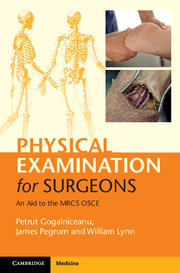Book contents
- Frontmatter
- Dedication
- Contents
- List of contributors
- Introduction
- Acknowledgments
- List of abbreviations
- Section 1 Principles of surgery
- Section 2 General surgery
- Section 3 Breast surgery
- Section 4 Pelvis and perineum
- Section 5 Orthopaedic surgery
- Section 6 Vascular surgery
- Section 7 Heart and thorax
- Section 8 Head and neck surgery
- Section 9 Neurosurgery
- Section 10 Plastic surgery
- Section 11 Surgical radiology
- 44 Principles of plain film
- 45 Chest x-ray
- 46 Abdominal x-ray
- 47 Mammogram
- 48 Facial x-ray
- 49 Cervical spine x-ray
- 50 Shoulder x-ray
- 51 Elbow x-ray
- 52 Wrist and distal forearm x-ray
- 53 Pelvis and hip x-ray
- 54 Knee x-ray
- 55 Foot and ankle x-ray
- 56 Principles of CT
- 57 Head CT
- 58 Chest CT
- 59 Abdomen CT
- 60 Aorta CT
- 61 Kidneys, ureter and bladder CT
- 62 Lower limb CT angiogram
- Section 12 Airway, trauma and critical care
- Index
55 - Foot and ankle x-ray
from Section 11 - Surgical radiology
Published online by Cambridge University Press: 05 July 2015
- Frontmatter
- Dedication
- Contents
- List of contributors
- Introduction
- Acknowledgments
- List of abbreviations
- Section 1 Principles of surgery
- Section 2 General surgery
- Section 3 Breast surgery
- Section 4 Pelvis and perineum
- Section 5 Orthopaedic surgery
- Section 6 Vascular surgery
- Section 7 Heart and thorax
- Section 8 Head and neck surgery
- Section 9 Neurosurgery
- Section 10 Plastic surgery
- Section 11 Surgical radiology
- 44 Principles of plain film
- 45 Chest x-ray
- 46 Abdominal x-ray
- 47 Mammogram
- 48 Facial x-ray
- 49 Cervical spine x-ray
- 50 Shoulder x-ray
- 51 Elbow x-ray
- 52 Wrist and distal forearm x-ray
- 53 Pelvis and hip x-ray
- 54 Knee x-ray
- 55 Foot and ankle x-ray
- 56 Principles of CT
- 57 Head CT
- 58 Chest CT
- 59 Abdomen CT
- 60 Aorta CT
- 61 Kidneys, ureter and bladder CT
- 62 Lower limb CT angiogram
- Section 12 Airway, trauma and critical care
- Index
Summary
Introduction
‘This is a radiograph of the right/left foot/ankle.’
Views
• Ankle – AP (shows medial clear space), lateral and mortice view (shows lateral clear space more clearly)
• Foot – DP (dorsoplantar: equivalent to AP) and oblique
Anatomy
Bones
• Malleoli, talus, calcaneus, tarsal bones, metatarsal bones, phalanges
Lines
• Foot DP – 2nd metatarsal medial border lines up with medial border middle cuneiform.
• Foot oblique – 3rd metatarsal medial border lines up with medial border of lateral cuneiform.
• Ankle AP – talar dome line is smooth throughout.
• Ankle lateral – Bohler's angle (normal 28–40°). The angle formed by the intersection of a line drawn from the highest point of the posterior tuberosity to the top of the posterior facet, and a line from the top of posterior facet to the tip of anterior process of calcaneum. If reduced can signify an occult calcaneal fracture.
Pathology
Fractures
• March fracture: 2nd or 3rd metatarsal stress fracture.
• Inversion injuries: base of 5th metatarsal.
• Lisfranc injury: disruption of Lisfranc ligament with or without fracture leads to lateral displacement of the 2nd metatarsal base with respect to the middle cuneiform. Weight-bearing views very useful in unmasking subtle injury.
Diabetic foot
• If no obvious fracture is seen, look for signs of osteomyelitis; bone destruction/osteolysis, usually involving calcaneum, 1st/5th metatarsal heads or distal phalanges; or bone changes and deformities suggestive of Charcot foot, typically involving the tarsometatarsal joints.
Foreign object
• Look for metallic objects, nails or glass in the soft tissues.
- Type
- Chapter
- Information
- Physical Examination for SurgeonsAn Aid to the MRCS OSCE, pp. 444 - 448Publisher: Cambridge University PressPrint publication year: 2015



